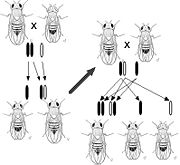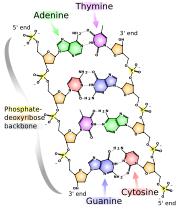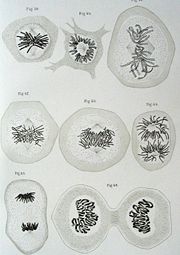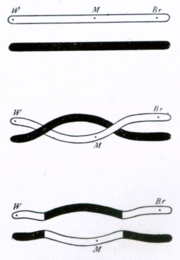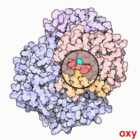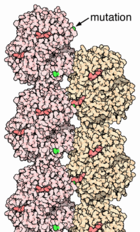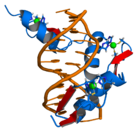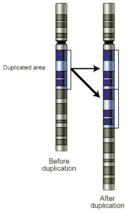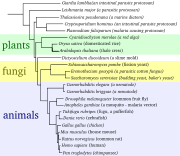Genetics
2008/9 Schools Wikipedia Selection. Related subjects: Biology
Genetics (from Ancient Greek γενετικός genetikos, “genitive” and that from γένεσις genesis, “origin”), a discipline of biology, is the science of heredity and variation in living organisms. The fact that living things inherit traits from their parents has been used since prehistoric times to improve crop plants and animals through selective breeding. However, the modern science of genetics, which seeks to understand the process of inheritance, only began with the work of Gregor Mendel in the mid-nineteenth century. Although he did not know the physical basis for heredity, Mendel observed that organisms inherit traits in a discrete manner—these basic units of inheritance are now called genes.
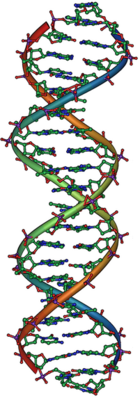
Genes correspond to regions within DNA, a molecule composed of a chain of four different types of nucleotides—the sequence of these nucleotides is the genetic information organisms inherit. DNA naturally occurs in a double stranded form, with nucleotides on each strand complementary to each other. Each strand can act as a template for creating a new partner strand—this is the physical method for making copies of genes that can be inherited.
The sequence of nucleotides in a gene is translated by cells to produce a chain of amino acids, creating proteins—the order of amino acids in a protein corresponds to the order of nucleotides in the gene. This is known as the genetic code. The amino acids in a protein determine how it folds into a three-dimensional shape; this structure is, in turn, responsible for the protein's function. Proteins carry out almost all the functions needed for cells to live. A change to the DNA in a gene can change a protein's amino acids, changing its shape and function: this can have a dramatic effect in the cell and on the organism as a whole.
Although genetics plays a large role in the appearance and behaviour of organisms, it is the combination of genetics with what an organism experiences that determines the ultimate outcome. For example, while genes play a role in determining a person's height, the nutrition and health that person experiences in childhood also have a large effect.
History
Although the science of genetics began with the applied and theoretical work of Gregor Mendel in the mid-1800s, other theories of inheritance preceded Mendel. A popular theory during Mendel's time was the concept of blending inheritance: the idea that individuals inherit a smooth blend of traits from their parents. Mendel's work disproved this, showing that traits are composed of combinations of distinct genes rather than a continuous blend. Another theory that had some support at that time was the inheritance of acquired characteristics: the belief that individuals inherit traits strengthened by their parents. This theory (commonly associated with Jean-Baptiste Lamarck) is now known to be wrong—the experiences of individuals do not affect the genes they pass to their children. Other theories included the pangenesis of Charles Darwin (which had both acquired and inherited aspects) and Francis Galton's reformulation of pangenesis as both particulate and inherited.
Mendelian and classical genetics
The modern science of genetics traces its roots to Gregor Johann Mendel, a German-Czech Augustinian monk and scientist who studied the nature of inheritance in plants. In his paper "Versuche über Pflanzenhybriden" (" Experiments on Plant Hybridization"), presented in 1865 to the Naturforschender Verein (Society for Research in Nature) in Brünn, Mendel traced the inheritance patterns of certain traits in pea plants and described them mathematically. Although this pattern of inheritance could only be observed for a few traits, Mendel's work suggested that heredity was particulate, not acquired, and that the inheritance patterns of many traits could be explained through simple rules and ratios.
The importance of Mendel's work did not gain wide understanding until the 1890s, after his death, when other scientists working on similar problems re-discovered his research. William Bateson, a proponent of Mendel's work, coined the word genetics in 1905. (The adjective genetic, derived from the Greek word genesis - γένεσις, "origin" and that from the word genno - γεννώ, "to give birth", predates the noun and was first used in a biological sense in 1860.) Bateson popularized the usage of the word genetics to describe the study of inheritance in his inaugural address to the Third International Conference on Plant Hybridization in London, England, in 1906.
After the rediscovery of Mendel's work, scientists tried to determine which molecules in the cell were responsible for inheritance. In 1910, Thomas Hunt Morgan argued that genes are on chromosomes, based on observations of a sex-linked white eye mutation in fruit flies. In 1913, his student Alfred Sturtevant used the phenomenon of genetic linkage to show that genes are arranged linearly on the chromosome.
Molecular genetics
Although genes were known to exist on chromosomes, chromosomes are composed of both protein and DNA—scientists did not know which of these was responsible for inheritance. In 1928, Frederick Griffith discovered the phenomenon of transformation (see Griffith's experiment): dead bacteria could transfer genetic material to "transform" other still-living bacteria. Sixteen years later, in 1944, Oswald Theodore Avery, Colin McLeod and Maclyn McCarty identified the molecule responsible for transformation as DNA. The Hershey-Chase experiment in 1952 also showed that DNA (rather than protein) was the genetic material of the viruses that infect bacteria, providing further evidence that DNA was the molecule responsible for inheritance.
James D. Watson and Francis Crick determined the structure of DNA in 1953, using the X-ray crystallography work of Rosalind Franklin that indicated DNA had a helical structure (i.e., shaped like a corkscrew). Their double-helix model had two strands of DNA with the nucleotides pointing inward, each matching a complementary nucleotide on the other strand to form what looks like rungs on a twisted ladder. This structure showed that genetic information exists in the sequence of nucleotides on each strand of DNA. The structure also suggested a simple method for duplication: if the strands are separated, new partner strands can be reconstructed for each based on the sequence of the old strand.
Although the structure of DNA showed how inheritance worked, it was still not known how DNA influenced the behaviour of cells. In the following years, scientists tried to understand how DNA controls the process of protein production. It was discovered that the cell uses DNA as a template to create matching messenger RNA (a molecule with nucleotides, very similar to DNA). The nucleotide sequence of a messenger RNA is used to create an amino acid sequence in protein; this translation between nucleotide and amino acid sequences is known as the genetic code.
With this molecular understanding of inheritance, an explosion of research became possible. One important development was chain-termination DNA sequencing in 1977 by Frederick Sanger: this technology allows scientists to read the nucleotide sequence of a DNA molecule. In 1983, Kary Banks Mullis developed the polymerase chain reaction, providing a quick way to isolate and amplify a specific section of a DNA from a mixture. Through the pooled efforts of the Human Genome Project and the parallel private effort by Celera Genomics, these and other techniques culminated in the sequencing of the human genome in 2003.
Features of inheritance
Discrete inheritance and Mendel's laws
At its most fundamental level, inheritance in organisms occurs by means of discrete traits, called genes. This property was first observed by Gregor Mendel, who studied the segregation of heritable traits in pea plants. In his experiments studying the trait for flower colour, Mendel observed that the flowers of each pea plant were either purple or white - and never an intermediate between the two colors. These different, discrete versions of the same gene are called alleles.
In the case of pea plants, each organism has two alleles of each gene, and the plants inherit one allele from each parent. Many organisms, including humans, have this pattern of inheritance. Organisms with two copies of the same allele are called homozygous, while organisms with two different alleles are heterozygous.
The set of alleles for a given organism is called its genotype, while the observable trait the organism has is called its phenotype. When organisms are heterozygous, often one allele is called dominant as its qualities dominate the phenotype of the organism, while the other allele is called recessive as its qualities recede and are not observed. Some alleles do not have complete dominance and instead have incomplete dominance by expressing an intermediate phenotype, or codominance by expressing both alleles at once.
When a pair of organisms reproduce sexually, their offspring randomly inherit one of the two alleles from each parent. These observations of discrete inheritance and the segregation of alleles are collectively known as Mendel's first law or the Law of Segregation.
Notation and diagrams
Geneticists use diagrams and symbols to describe inheritance. A gene is represented by a letter (or letters) - the capitalized letter represents the dominant allele and the recessive is represented by lowercase. Often a "+" symbol is used to mark the usual, non-mutant allele for a gene.
In fertilization and breeding experiments (and especially when discussing Mendel's laws) the parents are referred to as the "P" generation and the offspring as the "F1" (first filial) generation. When the F1 offspring mate with each other, the offspring are called the "F2" (second filial) generation. One of the common diagrams used to predict the result of cross-breeding is the Punnett square.
When studying human genetic diseases, geneticists often use pedigree charts to represent the inheritance of traits. These charts map the inheritance of a trait in a family tree.
Interactions of multiple genes
Organisms have thousands of genes, and in sexually reproducing organisms assortment of these genes are generally independent of each other. This means that the inheritance of an allele for yellow or green pea colour is unrelated to the inheritance of alleles for white or purple flowers. This phenomenon, known as " Mendel's second law" or the "Law of independent assortment", means that the alleles of different genes get shuffled between parents to form offspring with many different combinations.(Some genes do not assort independently, demonstrating genetic linkage, a topic discussed later in this article.)
Often different genes can interact in a way that influences the same trait. In the Blue-eyed Mary (Omphalodes verna), for example, there exists a gene with alleles that determine the color of flowers: blue or magenta. Another gene, however, controls whether the flowers have color at all: colour or white. When a plant has two copies of this white allele, its flowers are white - regardless of whether the first gene has blue or magenta alleles. This interaction between genes is called epistasis, with the second gene epistatic to the first.
Many traits are not discrete features (eg. purple or white flowers) but are instead continuous features (eg. human height and skin colour). These complex traits are the product of many genes. The influence of these genes is mediated, to varying degrees, by the environment an organism has experienced. The degree to which an organism's genes contribute to a complex trait is called heritability. Measurement of the heritability of a trait is relative - in a more variable environment, the environment has a bigger influence on the total variation of the trait. For example, human height is a complex trait with a heritability of 89% in the United States. In Nigeria, however, where people experience a more variable access to good nutrition and health care, height has a heritability of only 62%.
Molecular basis for inheritance
DNA and chromosomes
The molecular basis for genes is deoxyribonucleic acid (DNA). DNA is composed of a chain of nucleotides, of which there are four types: adenine (A), cytosine (C), guanine (G), and thymine (T). Genetic information exists in the sequence of these nucleotides, and genes exist as stretches of sequence along the DNA chain. Viruses are the only exception to this rule - sometimes viruses use the very similar molecule RNA instead of DNA as their genetic material.
DNA normally exists as a double-stranded molecule, coiled into the shape of a double-helix. Each nucleotide in DNA preferentially pairs with its partner nucleotide on the opposite strand: A pairs with T, and C pairs with G. Thus, in its two-stranded form, each strand effectively contains all necessary information, redundant with its partner strand. This structure of DNA is the physical basis for inheritance: DNA replication duplicates the genetic information by splitting the strands and using each strand as a template for synthesis of a new partner strand.
Genes are arranged linearly along long chains of DNA sequence, called chromosomes. In bacteria, each cell has a single circular chromosome, while eukaryotic organisms (which includes plants and animals) have their DNA arranged in multiple linear chromosomes. These DNA strands are often extremely long; the largest human chromosome, for example, is about 247 million base pairs in length. The DNA of a chromosome is associated with structural proteins that organize, compact, and control access to the DNA, forming a material called chromatin; in eukaryotes, chromatin is usually composed of nucleosomes, repeating units of DNA wound around a core of histone proteins. The full set of hereditary material in an organism (usually the combined DNA sequences of all chromosomes) is called the genome.
While haploid organisms have only one copy of each chromosome, most animals and many plants are diploid, containing two of each chromosome and thus two copies of every gene. The two alleles for a gene are located on identical loci of sister chromatids, each allele inherited from a different parent.
An exception exists in the sex chromosomes, specialized chromosomes many animals have evolved that play a role in determining the sex of an organism. In humans and other mammals, the Y chromosome has very few genes and triggers the development of male sexual characteristics, while the X chromosome is similar to the other chromosomes and contains many genes unrelated to sex determination. Females have two copies of the X chromosome, but males have one Y and only one X chromosome - this difference in X chromosome copy numbers leads to the unusual inheritance patterns of sex-linked disorders.
Reproduction
When cells divide, their full genome is copied and each daughter cell inherits one copy. This process, called mitosis, is the simplest form of reproduction and is the basis for asexual reproduction. Asexual reproduction can also occur in multicellular organisms, producing offspring that inherit their genome from a single parent. Offspring that are genetically identical to their parents are called clones.
Eukaryotic organisms often use sexual reproduction to generate offspring that contain a mixture of genetic material inherited from two different parents. The process of sexual reproduction alternates between forms that contain single copies of the genome ( haploid) and double copies ( diploid). Haploid cells fuse and combine genetic material to create a diploid cell with paired chromosomes. Diploid organisms form haploids by dividing, without replicating their DNA, to create daughter cells that randomly inherit one of each pair of chromosomes. Most animals and many plants are diploid for most of their lifespan, with the haploid form reduced to single cell gametes.
Although they do not use the haploid/diploid method of sexual reproduction, bacteria have many methods of acquiring new genetic information. Some bacteria can undergo conjugation, transferring a small circular piece of DNA to another bacterium. Bacteria can also take up raw DNA fragments found in the environment and integrate them into their genome, a phenomenon known as transformation. This processes result in horizontal gene transfer, transmitting fragments of genetic information between organisms that would be otherwise unrelated.
Recombination and linkage
The diploid nature of chromosomes allows for genes on different chromosomes to assort independently during sexual reproduction, recombining to form new combinations of genes. Genes on the same chromosome would theoretically never recombine, however, were it not for the process of chromosomal crossover. During crossover, chromosomes exchange stretches of DNA, effectively shuffling the gene alleles between the chromosomes. This process of chromosomal crossover generally occurs during meiosis, a series of cell divisions that creates haploid germ cells that later combine with other germ cells to form child organisms.
The probability of chromosomal crossover occurring between two given points on the chromosome is related to the distance between them. For an arbitrarily long distance, the probability of crossover is high enough that the inheritance of the genes is effectively uncorrelated. For genes that are closer together, however, the lower probability of crossover means that the genes demonstrate genetic linkage - alleles for the two genes tend to be inherited together. The amounts of linkage between a series of genes can be combined to form a linear linkage map that roughly describes the arrangement of the genes along the chromosome.
Gene expression
Genetic code

Genes generally express their functional effect through the production of proteins, which are complex molecules responsible for most functions in the cell. Proteins are chains of amino acids, and the DNA sequence of a gene (through RNA intermediate) is used to produce a specific protein sequence. This process begins with the production of an RNA molecule with a sequence matching the gene's DNA sequence, a process called transcription.
This messenger RNA molecule is then used to produce a corresponding amino acid sequence through a process called translation. Each group of three nucleotides in the sequence, called a codon, corresponds to one of the twenty possible amino acids in protein - this correspondence is called the genetic code. The flow of information is unidirectional: information is transferred from nucleotide sequences into the amino acid sequence of proteins, but it never transfers from protein back into the sequence of DNA—a phenomenon Francis Crick called the central dogma of molecular biology.
The specific sequence of amino acids results in a unique three-dimensional structure for that protein, and the three-dimensional structures of protein are related to their function. Some are simple structural molecules, like the fibers formed by the protein collagen. Proteins can bind to other proteins and simple molecules, sometimes acting as enzymes by facilitating chemical reactions within the bound molecules (without changing the structure of the protein itself). Protein structure is dynamic; the protein hemoglobin bends into slightly different forms as it facilitates the capture, transport, and release of oxygen molecules within mammalian blood.
A single nucleotide difference within DNA can cause a single change in the amino acid sequence of a protein. Because protein structures are the result of their amino acid sequences, some changes can dramatically change the properties of a protein by destabilizing the structure or changing the surface of the protein in a way that changes its interaction with other proteins and molecules. For example, sickle-cell anaemia is a human genetic disease that results from a single base difference within the coding region for the β-globin section of hemoglobin, causing a single amino acid change that changes hemoglobin's physical properties. Sickle-cell versions of hemoglobin stick to themselves, stacking to form fibers that distort the shape of red blood cells carrying the protein. These sickle-shaped cells no longer flow smoothly through blood vessels, having a tendency to clog or degrade, causing the medical problems associated with this disease.
Some genes are transcribed into RNA but are not translated into protein products - these are called non-coding RNA molecules. In some cases, these products fold into structures which are involved in critical cell functions (eg. ribosomal RNA and transfer RNA). RNA can also have regulatory effect through hybridization interactions with other RNA molecules (eg. microRNA).
Nature versus nurture
Although genes contain all the information an organism uses to function, the environment plays an important role in determining the ultimate phenotype—a dichotomy often referred to as " nature vs. nurture." The phenotype of an organism depends on the interaction of genetics with the environment. One example of this is the case of temperature-sensitive mutations. Often, a single amino acid change within the sequence of a protein does not change its behaviour and interactions with other molecules, but it does destabilize the structure. In a high temperature environment, where molecules are moving more quickly and hitting each other, this results in the protein losing its structure and failing to function. In a low temperature environment, however, the protein's structure is stable and functions normally. This type of mutation is visible in the coat coloration of Siamese cats, where a mutation in an enzyme responsible for pigment production causes it to destabilize and lose function at high temperatures. The protein remains functional in areas of skin that are colder—legs, ears, tail, and face—and so the cat has dark fur at its extremities.
Environment also plays a dramatic role in effects of the human genetic disease phenylketonuria. The mutation that causes phenylketonuria disrupts the ability of the body to break down the amino acid phenylalanine, causing a toxic build-up of an intermediate molecule that, in turn, causes severe symptoms of progressive mental retardation and seizures. If someone with the phenylketonuria mutation follows a strict diet that avoids this amino acid, however, they remain normal and healthy.
Gene regulation
The genome of a given organism contains thousands of genes, but not all these genes need to be active at any given moment. A gene is expressed when it is being transcribed into mRNA (and translated into protein), and there exist many cellular methods of controlling the expression of genes such that proteins are produced only when needed by the cell. Transcription factors are regulatory proteins that bind to the start of genes, either promoting or inhibiting the transcription of the gene. Within the genome of Escherichia coli bacteria, for example, there exists a series of genes necessary for the synthesis of the amino acid tryptophan. However, when tryptophan is already available to the cell, these genes for tryptophan synthesis are no longer needed. The presence of tryptophan directly affects the activity of the genes—tryptophan molecules bind to the tryptophan repressor (a transcription factor), changing the repressor's structure such that the repressor binds to the genes. The tryptophan repressor blocks the transcription and expression of the genes, thereby creating negative feedback regulation of the tryptophan synthesis process.
Differences in gene expression are especially clear within multicellular organisms, where cells all contain the same genome but have very different structures and behaviors due to the expression of different sets of genes. All the cells in a multicellular organism derive from a single cell, differentiating into variant cell types in response to external and intercellular signals and gradually establishing different patterns of gene expression to create different behaviors. As no single gene is responsible for the development of structures within multicellular organisms, these patterns arise from the complex interactions between many cells.
Within eukaryotes there exist structural features of chromatin that influence the transcription of genes, often in the form of modifications to DNA and chromatin that are stably inherited by daughter cells. These features are called " epigenetic" because they exist "on top" of the DNA sequence and retain inheritance from one cell generation to the next. Because of epigenetic features, different cell types grown within the same medium can retain very different properties. Although epigenetic features are generally dynamic over the course of development, some, like the phenomenon of paramutation, have multigenerational inheritance and exist as rare exceptions to the general rule of DNA as the basis for inheritance.
Genetic change
Mutations
During the process of DNA replication, errors occasionally occur in the polymerization of the second strand. These errors, called mutations, can have an impact on the phenotype of an organism, especially if they occur within the protein coding sequence of a gene. Error rates are usually very low—1 error in every 10–100 million bases—due to the "proofreading" ability of DNA polymerases. (Without proofreading error rates are a thousand-fold higher; because many viruses rely on DNA and RNA polymerases that lack proofreading ability, they experience higher mutation rates.) Processes that increase the rate of changes in DNA are called mutagenic: mutagenic chemicals promote errors in DNA replication, often by interfering with the structure of base-pairing, while UV radiation induces mutations by causing damage to the DNA structure. Chemical damage to DNA occurs naturally as well, and cells use DNA repair mechanisms to repair mismatches and breaks in DNA—nevertheless, the repair sometimes fails to return the DNA to its original sequence.
In organisms that use chromosomal crossover to exchange DNA and recombine genes, errors in alignment during meiosis can also cause mutations. Errors in crossover are especially likely when similar sequences cause partner chromosomes to adopt a mistaken alignment; this makes some regions in genomes more prone to mutating in this way. These errors create large structural changes in DNA sequence— duplications, inversions or deletions of entire regions, or the accidental exchanging of whole parts between different chromosomes (called translocation).
Natural selection and evolution
Mutations produce organisms with different genotypes, and those differences can result in different phenotypes. Many mutations have little effect on an organism's phenotype, health, and reproductive fitness. Mutations that do have an effect are often deleterious, but occasionally mutations are beneficial. Studies in the fly Drosophila melanogaster suggest that if a mutation changes a protein produced by a gene, this will probably be harmful, with about 70 percent of these mutations having damaging effects, and the remainder being either neutral or weakly beneficial.
Population genetics research studies the distributions of these genetic differences within populations and how the distributions change over time. Changes in the frequency of an allele in a population can be influenced by natural selection, where a given allele's higher rate of survival and reproduction causes it to become more frequent in the population over time. Genetic drift can also occur, where chance events lead to random changes in allele frequency.
Over many generations, the genomes of organisms can change, resulting in the phenomenon of evolution. Mutations and the selection for beneficial mutations can cause a species to evolve into forms that better survive their environment, a process called adaptation. New species are formed through the process of speciation, a process often caused by geographical separations that allow different populations to genetically diverge. The application of genetic principles to the study of population biology and evolution is referred to as the modern synthesis.
As sequences diverge and change during the process of evolution, these differences between sequences can be used as a molecular clock to calculate the evolutionary distance between them. Genetic comparisons are generally considered the most accurate method of characterizing the relatedness between species, an improvement over the sometimes deceptive comparison of phenotypic characteristics. The evolutionary distances between species can be combined to form evolutionary trees - these trees represent the common descent and divergence of species over time, although they cannot represent the transfer of genetic material between unrelated species (known as horizontal gene transfer and most common in bacteria).
Research and technology
Model organisms and genetics
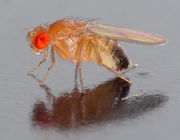
Although geneticists originally studied inheritance in a wide range of organisms, researchers began to specialize in studying the genetics of a particular subset of organisms. The fact that significant research already existed for a given organism would encourage new researchers to choose it for further study, and so eventually a few model organisms became the basis for most genetics research. Common research topics in model organism genetics include the study of gene regulation and the involvement of genes in development and cancer.
Organisms were chosen, in part, for convenience—short generation times and easy genetic manipulation made some organisms popular genetics research tools. Widely used model organisms include the gut bacterium Escherichia coli, the plant Arabidopsis thaliana, baker's yeast ( Saccharomyces cerevisiae), the nematode Caenorhabditis elegans, the common fruit fly (Drosophila melanogaster), and the common house mouse ( Mus musculus).
Medical genetics research
Medical genetics seeks to understand how genetic variation relates to human health and disease. When searching for an unknown gene that may be involved in a disease, researchers commonly use genetic linkage and genetic pedigree charts to find the location on the genome associated with the disease. At the population level, researchers take advantage of Mendelian randomization to look for locations in the genome that are associated with diseases, a technique especially useful for multigenic traits not clearly defined by a single gene. Once a candidate gene is found, further research is often done on the same gene (called an orthologous gene) in model organisms. In addition to studying genetic diseases, the increased availability of genotyping techniques has led to the field of pharmacogenetics—studying how genotype can affect drug responses.
Although it is not an inherited disease, cancer is also considered a genetic disease. The process of cancer development in the body is a combination of events. Mutations occasionally occur within cells in the body as they divide. While these mutations will not be inherited by any offspring, they can affect the behaviour of cells, sometimes causing them to grow and divide more frequently. There are biological mechanisms that attempt to stop this process; signals are given to inappropriately dividing cells that should trigger cell death, but sometimes additional mutations occur that cause cells to ignore these messages. An internal process of natural selection occurs within the body and eventually mutations accumulate within cells to promote their own growth, creating a cancerous tumor that grows and invades various tissues of the body.
Research techniques
DNA can be manipulated in the laboratory. Restriction enzymes are a commonly used enzyme that cuts DNA at specific sequences, producing predictable fragments of DNA. The use of ligation enzymes allows these fragments to be reconnected, and by ligating fragments of DNA together from different sources, researchers can create recombinant DNA. Often associated with genetically modified organisms, recombinant DNA is commonly used in the context of plasmids - short circular DNA fragments with a few genes on them. By inserting plasmids into bacteria and growing those bacteria on plates of agar (to isolate clones of bacteria cells), researchers can clonally amplify the inserted fragment of DNA (a process known as molecular cloning). (Cloning can also refer to the creation of clonal organisms, through various techniques.)
DNA can also be amplified using a procedure called the polymerase chain reaction (PCR). By using specific short sequences of DNA, PCR can isolate and exponentially amplify a targeted region of DNA. Because it can amplify from extremely small amounts of DNA, PCR is also often used to detect the presence of specific DNA sequences.
DNA sequencing and genomics
One of the most fundamental technologies developed to study genetics, DNA sequencing allows researchers to determine the sequence of nucleotides in DNA fragments. Developed in 1977 by Frederick Sanger and coworkers, chain-termination sequencing is now routinely used to sequence DNA fragments. With this technology, researchers have been able to study the molecular sequences associated with many human diseases.
As sequencing has become less expensive and with the aid of computational tools, researchers have sequenced the genomes of many organisms by stitching together the sequences of many different fragments (a process called genome assembly). These technologies were used to sequence the human genome, leading to the completion of the Human Genome Project in 2003. New high-throughput sequencing technologies are dramatically lowering the cost of DNA sequencing, with many researchers hoping to bring the cost of resequencing a human genome down to a thousand dollars.
The large amount of sequences available has created the field of genomics, research that uses computational tools to search for and analyze patterns in the full genomes of organisms. Genomics can also be considered a subfield of bioinformatics, which uses computational approaches to analyze large sets of biological data.
